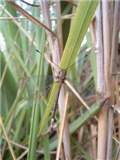Synonymy
= Laidlawiella pulchra Esben-Petersen, 1927
= Balanopteryx mellisi Navás, 1935
= Balanopteryx umbraticus Fraser, 1958
Diagnosis
This is one of the Madagascar species with the long, narrow anal extension near the base of the forewing. Males have the basal half of the hind wing darkened and females have the leading edge of both wings darkened. Some females have a pure white pterostigma, while others have a darker, reddish pterostigma.
Type Depository
Holotype female of Balanopteryx locuples is in HMB, Berlin.
Holotype male of Laidlawiella pulchra is in BMNH, London.
Lectotype male of Balanopteryx mellisi is in MNHN, Paris.
Syntypes (1 male, 2 females) of Balanopteryx umbraticus is in SME, Edinburgh.
Type Locality
of Balanopteryx locuples is Madagascar, Hildebrandt (nospecific locality; no date), 1 female.
of Laidlawiella pulchra is Madagascar: Toamasina Province, Lac Alaotra (no date; no collector), 1 male.
of Balanopteryx mellisi is Madagascar: Antsiranana Province, NE of Ambanja, October1933 - January 1934 (no collector), 1 male.
of Balanopteryx umbraticus is Madagascar: Toliara, Sakaraha, 20 March 1968, K.M. Guichard, 1 male, and Andranovory, 20 March 1968, K.M. Guichard, 2 females.
Geographical Distribution
This species is endemic to Madagascar and appears to be found mostly in the dry western parts of the country at low and mid elevations (see map).
Temporal Distribution
From October to April, with one record from late July.
Elevation
40 - 1125 m.
Remarks
This is the most widely distributed and frequently collected ascalaphid in Madagascar. There is very distinctive sexual dimorphism in this species. Originally females were placed in Balanopteryx and males in Laidlawiella. In addition to obvious differences in color pattern of the wings, males have slightly longer antennae and longer hairs on the tip of the abdomen.
References
Esben-Petersen, P. 1927. New species of Neuroptera Planipennia in British collections. Proceedings of the Zoological Society of London 1927:549-551. 2 figures [#1-2].
Fraser, F. C. 1957. Deux nouvelles especes d'Ascalaphides de Madagascar (Nevroptera). Naturaliste Malgache 9:247-250. 2 figures.
Karsch, F. 1889. Beitrag zur Kenntniss der Askalaphiden Madagaskar's. Berliner Entomologische Zeitschrift 33:269-272. No figures.
Navás, L. 1934 [1935.04.24]. Comunicaciones entomolÓgicas. 18. Insectos de Madagascar. Segunda [II] serie. Revista de la [Real] Academia de Ciencias Exactas Fisico-Quimicas y Naturales de Zaragoza (1)18:42-74. 17 figures [#18-34].
Tjeder, B. and C. Hansson. 1992. The Ascalaphidae of the Afrotropical Region (Neuroptera). Entomologica scandinavica. Supplement No. 41.



